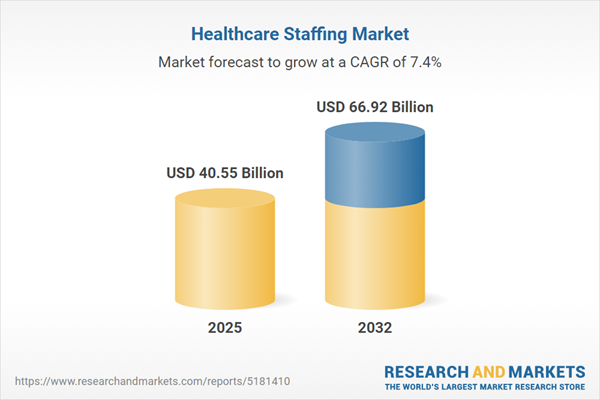Speak directly to the analyst to clarify any post sales queries you may have.
The healthcare staffing market is undergoing fundamental change, with technology integration, policy developments, and workforce expectations reshaping how healthcare providers secure critical talent across care settings.
Market Snapshot: Healthcare Staffing Market Growth and Outlook
The Healthcare Staffing Market grew from USD 37.69 billion in 2024 to USD 40.55 billion in 2025. It is expected to expand steadily at a CAGR of 7.44%, reaching USD 66.92 billion by 2032. Sustained growth is driven by ongoing workforce challenges, evolving care delivery modes, and increased demand for adaptive staffing models. Healthcare decision-makers face mounting pressure to maintain care quality while adapting to unprecedented clinical and operational change.
Scope & Segmentation: Comprehensive Market Coverage
This report analyzes market dynamics across diverse staffing, facility, employment, and shift types, as well as by major geographical regions and key industry participants.
- Staffing Types: Allied health (laboratory technician, occupational therapist, physical therapist, radiology technologist, respiratory therapist), nurse staffing (contract nurse, per diem nurse, permanent placement, travel nurse—long and short term), physician staffing (locum tenens—anesthesiology, emergency medicine, permanent physicians), and therapy staffing (occupational, physical, speech therapist staffing).
- Facility Types: Ambulatory surgery centers, clinics, hospitals, long term care facilities.
- Employment Models: Contract, permanent, and temporary staffing arrangements.
- Shift Structures: Day shift, night shift, and swing shift.
- Geographical Regions: Americas (United States, Canada, Mexico, Brazil, Argentina, Chile, Colombia, Peru), EMEA (United Kingdom, Germany, France, Russia, Italy, Spain, Netherlands, Sweden, Poland, Switzerland, United Arab Emirates, Saudi Arabia, Qatar, Turkey, Israel, South Africa, Nigeria, Egypt, Kenya), and Asia-Pacific (China, India, Japan, Australia, South Korea, Indonesia, Thailand, Malaysia, Singapore, Taiwan).
- Leading Providers: AMN Healthcare Services, CHG Healthcare Services, Cross Country Healthcare, Aya Healthcare, Maxim Healthcare Services, Supplemental Health Care, Favorite Healthcare Staffing, Aureus Medical Group, Medical Solutions, Atlas Medstaff.
Key Takeaways: Strategic Insights for Senior Decision-Makers
- Healthcare organizations must adapt to persistent staffing shortages by leveraging digital platforms and AI-driven scheduling, enabling proactive workforce planning and faster placement processes.
- Flexible work models and travel staffing arrangements have become vital, empowering professionals to navigate assignments regionally and providers to align supply with fluctuating demand.
- Regulatory changes, including expanded scope-of-practice and streamlined credentialing, continue to influence the ability of allied health professionals and nurse practitioners to take on broader responsibilities, especially in underserved regions.
- As telehealth adoption increases, staffing solutions must support virtual care delivery and decentralized clinical operations, requiring integration of technology and cross-border talent strategies.
- Mergers, acquisitions, and service differentiation—such as analytical workforce solutions and training partnerships—are shaping competitive positioning and enabling providers to address evolving market needs.
Tariff Impact: Navigating U.S. Policy Changes in 2025
Forthcoming U.S. tariff measures are set to impact equipment costs and cross-border workforce flows, increasing supply chain pressures and administrative expenses. Successful organizations are adopting collaborative procurement strategies and adjusting remuneration packages to safeguard workforce availability and maintain service continuity during changing trade conditions.
Methodology & Data Sources
This analysis integrates primary data from interviews with senior executives, supplemented by secondary research using industry publications, clinical reports, official statistics, and proprietary databases. Quantitative and qualitative findings have been validated through multiple quality control steps to ensure reliability and practical relevance for decision-making.
Why This Report Matters
- Senior stakeholders gain actionable insights into shifting workforce dynamics, policy changes, and technology-driven staffing strategies across core segments and regions.
- Utilization of this data aids in optimizing resource allocation, risk mitigation, and leadership decision-making in a competitive and evolving healthcare environment.
Conclusion
The healthcare staffing market is at a turning point, requiring adaptability and collaboration to achieve both operational resilience and clinical excellence. By acting on these insights, leadership teams can successfully meet future staffing challenges and secure long-term stability.
Additional Product Information:
- Purchase of this report includes 1 year online access with quarterly updates.
- This report can be updated on request. Please contact our Customer Experience team using the Ask a Question widget on our website.
Table of Contents
3. Executive Summary
4. Market Overview
7. Cumulative Impact of Artificial Intelligence 2025
Companies Mentioned
The companies profiled in this Healthcare Staffing market report include:- AMN Healthcare Services, Inc.
- CHG Healthcare Services, Inc.
- Cross Country Healthcare, Inc.
- Aya Healthcare Inc.
- Maxim Healthcare Services, Inc.
- Supplemental Health Care, Inc.
- Favorite Healthcare Staffing, Inc.
- Aureus Medical Group, LLC
- Medical Solutions, LLC
- Atlas Medstaff, LLC
Table Information
| Report Attribute | Details |
|---|---|
| No. of Pages | 193 |
| Published | November 2025 |
| Forecast Period | 2025 - 2032 |
| Estimated Market Value ( USD | $ 40.55 Billion |
| Forecasted Market Value ( USD | $ 66.92 Billion |
| Compound Annual Growth Rate | 7.4% |
| Regions Covered | Global |
| No. of Companies Mentioned | 11 |









